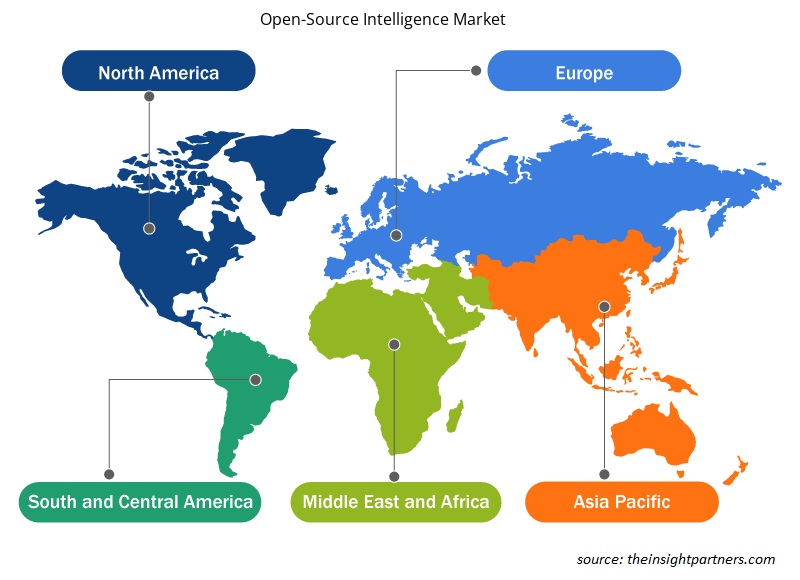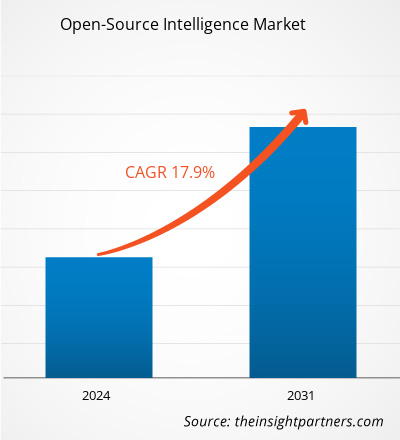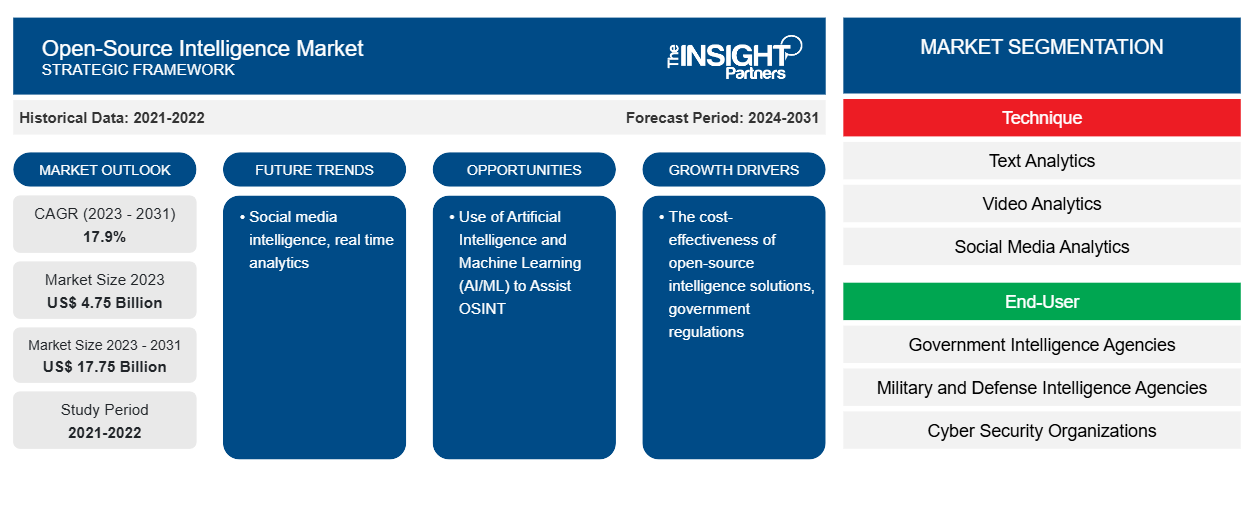Si prevede che la dimensione del mercato dell'intelligence open source raggiungerà i 17,75 miliardi di dollari entro il 2031, rispetto ai 4,75 miliardi di dollari del 2023. Si prevede che il mercato registrerà un CAGR del 17,9% nel periodo 2023-2031. È probabile che l'intelligence dei social media e l'analisi in tempo reale rimangano una tendenza chiave nel mercato.CAGR of 17.9% during 2023–2031. Social media intelligence and real-time analytics are likely to remain a key trend in the market.
Analisi di mercato dell'intelligence open source
L'intelligence derivata dalla raccolta, valutazione e analisi di dati accessibili al pubblico per rispondere a una particolare query di intelligence è nota come Open-Source Intelligence (OSINT). Come strumento di sicurezza informatica, OSINT è ampiamente utilizzato dalle aziende per valutare le minacce alla sicurezza e trovare falle nella loro infrastruttura IT. Gli hacker e i criminali informatici impiegano anche tecniche OSINT per phishing, ingegneria sociale e rivelazione di potenziali obiettivi per attacchi informatici. Oltre alla sicurezza informatica, l'intelligence open source può anche essere utilizzata in settori come l'applicazione della legge, il marketing, la sicurezza nazionale, i media e lo studio accademicopublically accessible data to address a particular intelligence query is known as Open-Source Intelligence (OSINT). As a cybersecurity tool, OSINT is widely used by enterprises to assess security threats and find holes in their IT infrastructure. Hackers and cybercriminals also employ OSINT techniques for phishing, social engineering, and revealing potential targets for cyberattacks. Beyond cybersecurity, open-source intelligence may also be used in fields like law enforcement, marketing, national security, media, and
Panoramica del mercato dell'intelligence open source
Negli ultimi anni, la disinformazione e le campagne di cattiva informazione hanno attirato maggiore attenzione in quanto pericolo per la sicurezza nazionale e la società in generale. Negli ultimi anni, questi rischi sono cambiati a causa di persistenti disordini politici che hanno consentito la diffusione di informazioni fuorvianti. Di conseguenza, l'ecosistema attorno alla disinformazione e alla contro-disinformazione è diventato più professionale. In tal modo, si è sviluppata la domanda per il mercato dell'intelligence open source.
Personalizza questo report in base alle tue esigenze
Riceverai la personalizzazione gratuita di qualsiasi report, comprese parti di questo report, o analisi a livello nazionale, pacchetto dati Excel, oltre a usufruire di grandi offerte e sconti per start-up e università
-
Scopri le principali tendenze di mercato in questo rapporto.Questo campione GRATUITO includerà analisi di dati che spaziano dalle tendenze di mercato alle stime e alle previsioni.
Driver e opportunità del mercato dell'intelligence open source
Efficacia dei costi delle soluzioni di intelligence open source per favorire il mercato
Rispetto ad altre forme di raccolta di informazioni, OSINT è meno costosa poiché si concentra su informazioni che sono prontamente disponibili al pubblico. Inoltre, è molto più fattibile perché tutto il software e gli strumenti necessari per assistere la raccolta di informazioni open source sono principalmente offerti a un prezzo equo al pubblico in generale. Di conseguenza, OSINT è una risorsa importante per le aziende di tutte le forme e dimensioni. Migliorando altri tipi di intelligence, OSINT può aiutare le aziende più consolidate a diventare più consapevoli delle loro impronte digitali, vulnerabilità e minacce.
Utilizzo dell'intelligenza artificiale e dell'apprendimento automatico (AI/ML) per supportare l'OSINTOSINT
Con lo sviluppo della tecnologia OSINT, un numero crescente di persone suggerisce che AI e ML vengano utilizzati per supportare la ricerca OSINT. Rapporti pubblici affermano che l'intelligenza artificiale è già utilizzata da organizzazioni di intelligence e governative per raccogliere ed elaborare dati sui social media. AI e ML vengono utilizzati da gruppi militari per rilevare e contrastare la criminalità informatica organizzata, la falsa propaganda, il terrorismo e altre minacce alla sicurezza nazionale sulle piattaforme dei social media.OSINT technology develops, a growing number of people are suggesting that AI and ML be used to support OSINT research. Public reports state that artificial intelligence is already being used by intelligence and government organizations to collect and process social media data. AI and ML are being used by military groups to detect and counteract organized cybercrime, false propaganda,
Analisi della segmentazione del rapporto di mercato dell'intelligence open source
I segmenti chiave che hanno contribuito alla derivazione dell'analisi di mercato dell'intelligence open source sono la tecnica e l'utente finale.
- In base alla tecnica, il mercato dell'intelligence open source è suddiviso in analisi di testo, analisi video, analisi dei social media, analisi geospaziale, analisi della sicurezza e altri. Il segmento dell'analisi della sicurezza ha detenuto la quota maggiore nel 2023.geospatial analytics, security analytics, and others. The security analytics segment held the largest share in 2023.
- In base all'utente finale, il mercato è suddiviso in agenzie di intelligence governative, agenzie di intelligence militari e di difesa, organizzazioni per la sicurezza informatica, forze dell'ordine, aziende private specializzate, servizi finanziari e altri.cyber security organizations, law enforcement agencies, private specialized businesses, financial services, and others.
Analisi della quota di mercato dell'intelligence open source per area geografica
L'ambito geografico del rapporto sul mercato dell'intelligence open source è suddiviso principalmente in cinque regioni: Nord America, Asia Pacifico, Europa, Medio Oriente e Africa, Sud e Centro America.
Il Nord America detiene una quota significativa del mercato dell'intelligence open source nel 2023. Paesi come gli Stati Uniti e il Canada hanno un'infrastruttura IT di rilievo per coltivare e sviluppare soluzioni come OSINT. Inoltre, questi paesi hanno un budget significativo per la digitalizzazione nei loro settori della difesa e militare, che sta guidando la domanda nella regione.OSINT. Moreover, these countries have a significant digitalization budget in their defense and military sectors, which is driving the demand in the region.
Approfondimenti regionali sul mercato dell'intelligence open source
Le tendenze regionali e i fattori che influenzano il mercato dell'intelligence open source durante il periodo di previsione sono stati ampiamente spiegati dagli analisti di Insight Partners. Questa sezione discute anche i segmenti e la geografia del mercato dell'intelligence open source in Nord America, Europa, Asia Pacifico, Medio Oriente e Africa e America centrale e meridionale.

- Ottieni i dati specifici regionali per il mercato dell'intelligence open source
Ambito del rapporto sul mercato dell'intelligence open source
| Attributo del report | Dettagli |
|---|---|
| Dimensioni del mercato nel 2023 | 4,75 miliardi di dollari USA |
| Dimensioni del mercato entro il 2031 | 17,75 miliardi di dollari USA |
| CAGR globale (2023-2031) | 17,9% |
| Dati storici | 2021-2022 |
| Periodo di previsione | 2024-2031 |
| Segmenti coperti |
Per tecnica
|
| Regioni e Paesi coperti |
America del Nord
|
| Leader di mercato e profili aziendali chiave |
|
Densità dei player del mercato dell'intelligence open source: comprendere il suo impatto sulle dinamiche aziendali
Il mercato dell'Open-Source Intelligence Market sta crescendo rapidamente, spinto dalla crescente domanda degli utenti finali dovuta a fattori quali l'evoluzione delle preferenze dei consumatori, i progressi tecnologici e una maggiore consapevolezza dei vantaggi del prodotto. Con l'aumento della domanda, le aziende stanno ampliando le loro offerte, innovando per soddisfare le esigenze dei consumatori e capitalizzando sulle tendenze emergenti, il che alimenta ulteriormente la crescita del mercato.
La densità degli operatori di mercato si riferisce alla distribuzione di aziende o società che operano in un particolare mercato o settore. Indica quanti concorrenti (operatori di mercato) sono presenti in un dato spazio di mercato in relazione alle sue dimensioni o al valore di mercato totale.
Le principali aziende che operano nel mercato dell'intelligence open source sono:
- Azienda
- Cellebrite
- Sistema Esperto SpA
- Società a responsabilità limitata Google LLC
- Tecnologie Maltego
- Tecnologie NetSentries FZCO
Disclaimer : le aziende elencate sopra non sono classificate secondo un ordine particolare.

- Ottieni una panoramica dei principali attori del mercato dell'intelligence open source
Notizie e sviluppi recenti del mercato dell'intelligence open source
Il mercato dell'intelligence open source viene valutato raccogliendo dati qualitativi e quantitativi dopo la ricerca primaria e secondaria, che includono importanti pubblicazioni aziendali, dati associativi e database. Di seguito sono elencati alcuni degli sviluppi nel mercato dell'intelligence open source:
- La società di intelligence open source Digital Clues AG ("Digital Clues") ha firmato un accordo formale per vendere i suoi asset a Cellebrite (Nasdaq: CLBT), leader nelle soluzioni di Digital Intelligence (DI) per i settori pubblico e privato. Si prevede che l'acquisizione contribuirà ad espandere la presenza globale di Cellebrite all'interno delle unità di intelligence e investigazione delle forze dell'ordine, a rafforzare la piattaforma di Digital Intelligence leader del settore dell'azienda e a consolidare la sua posizione di partner tecnologico end-to-end in grado di digitalizzare l'intero flusso di lavoro investigativo. (Fonte: Cellebrite, comunicato stampa, ottobre 2021)
- Maltego Technologies ha presentato ufficialmente i piani Maltego Professional e Organization per fornire agli utenti esistenti e nuovi maggiori capacità investigative, dati e servizi. (Fonte: Maltego Technologies, comunicato stampa, maggio 2024)
Copertura e risultati del rapporto sul mercato dell'intelligence open source
Il rapporto “Dimensioni e previsioni del mercato dell’intelligence open source (2021-2031)” fornisce un’analisi dettagliata del mercato che copre le seguenti aree:
- Dimensioni e previsioni del mercato dell'intelligence open source a livello globale, regionale e nazionale per tutti i segmenti di mercato chiave coperti dall'ambito
- Tendenze del mercato dell'intelligence open source, nonché dinamiche di mercato quali driver, vincoli e opportunità chiave
- Analisi dettagliata delle cinque forze PEST/Porter e SWOT
- Analisi di mercato dell'intelligence open source che copre le principali tendenze di mercato, il quadro globale e regionale, i principali attori, le normative e i recenti sviluppi del mercato
- Analisi del panorama industriale e della concorrenza che copre la concentrazione del mercato, l'analisi della mappa di calore, i principali attori e gli sviluppi recenti per il mercato dell'intelligence open source
- Profili aziendali dettagliati
- Analisi storica (2 anni), anno base, previsione (7 anni) con CAGR
- Analisi PEST e SWOT
- Valore/volume delle dimensioni del mercato - Globale, Regionale, Nazionale
- Industria e panorama competitivo
- Set di dati Excel
Report recenti
Testimonianze
Motivo dell'acquisto
- Processo decisionale informato
- Comprensione delle dinamiche di mercato
- Analisi competitiva
- Analisi dei clienti
- Previsioni di mercato
- Mitigazione del rischio
- Pianificazione strategica
- Giustificazione degli investimenti
- Identificazione dei mercati emergenti
- Miglioramento delle strategie di marketing
- Aumento dell'efficienza operativa
- Allineamento alle tendenze normative























 Ottieni un campione gratuito per - Mercato dell'intelligence open source
Ottieni un campione gratuito per - Mercato dell'intelligence open source